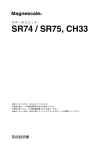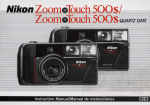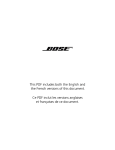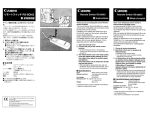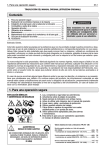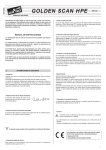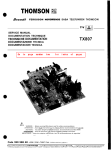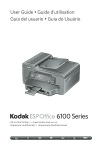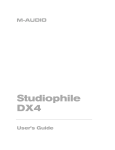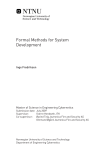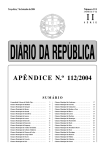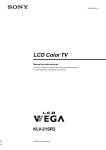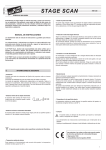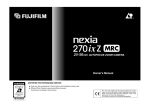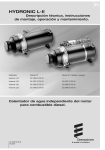Download Nuvis mini i only
Transcript
Nikon Nuvis mini
Nuvisminii
Instruction Manual (Pages 2-29)
Manual de instrucciones (Paginas 30-57)
FOREWORD
~~---
II
Thank you for purchasing the Nikon Nuvis mini/Nuvis mini i.
To obtain the best results from your new camera, be sure to read through this
instruction manual thoroughly.
This compact camera employs the Advanced Photo System (IX240 System) and
features:
- Simple "drop-in" film loading
- Three different print aspect ratios on the same roll of film
- Accidental double exposure prevention
- Convenient data printing (Nuvis mini i only)
2
Note: Before using your camera for an important occasion such as a wedding or
holiday, take some trial shots to familiarize yourself with all of its features
Nuvis mini i only: Setting the date and time (page 12)
Data recording function (page 13)
FOREWORD
I WARNING: for safe handling of the camera
Camera body
Built-in flash
• Do not disassemble or modify the camera, as it houses high-voltage circuitry
which can cause electric shocks.
• Do not touch inside metal portions of the flash if damaged, as it houses highvoltage circuitry which can cause electric shocks.
• Do not look at the sun or a strong light source directly through the viewfinder,
as it may damage your retina. Looking at the sun directly through the lens may
result in permanent eye damage.
• Do not carry the camera when mounted on a tripod, to avoid injury resulting
from a fall.
• If you detect smoke around the camera, immediately stop operation and turn
OFF the camera. Let the camera cool before taking it to your local Nikon dealer.
Do not fire the flash close people's eyes, as it may cause visual injury
Battery
• Do not throw used batteries into the fire. Do not short circuit, disassemble or
heat the battery: this may cause it to explode resulting injury.
• Keep battery out of children's reach. If someone accidentally swallows a battery, call a doctor immediately.
Note: Nikon cannot be held responsible for malfunctrons caused by uSing the
Nuvis mini/Nuvis mini i in ways not specified in this manual.
3
CONTENTS
FOREWORD ............................................................................................................................................ 2
WARNING: for safe handling of the camera .....................
.......................... .......
.. ........ 3
CONTENTS .............................................................................................. ;..............................................
QUICK GUIDE .................................... ............. .................... ............ ........................................ .................
CAMERA PARTS .....................................................................................................................................
LCD PANEL ............................................................................................................................................
4
6
8
9
PREPARATIONS ................................................................................................................................... 10
Attaching the strap .................................... ..
Installing the battery .............. .. .. ........ ................ ..
Checking battery level ......... ........... ...... .
Setting the date and time (Nuvis mini i only) ......................... ..
Data recording function (Nuvis mini i only)
Loading the film
.......... .... ... ......... ..... ....
....
.. .... ... .
...
......... .
....
10
10
11
12
13
14
BASIC OPERATION ............................................................................................................................... 17
Holding the camera ................. ..
Shutter release button
4
. ...... 17
......... .. ....................... 17
CONTENTS
Print aspect ratio
Viewfinder ... .......... .... ..... .
Focus and auto flash
Using focus lock .. .. .................
Removing the film
18
19
.. ... 20
.. 22
.. .
23
ADVANCED FUNCTIONS ...... ...................... ......................... .............................................. ............. .. ..... 24
Red-eye reduction .. .......... .. .......... ..
Anytime flash
Flash-cancel
Slow sync flash
Self-timer .. ... .... .. .... .. .. .. .. .. .. ..
.... .. 24
... .. . . . .. .
25
.. ... 25
.... .. 26
... ... 26
MISCELLANEOUS ................................... ................................................................................. .. ........... 27
For safe handling of the camera
Specifications .... ... ... ..... .... .. ..
....
..... .... ... . . 27
...... . 28
5
QUICK GUIDE
This quick guide shows you how to take photog raphs rig ht away with your new camera. Refer to the page numbers below for more details.
ON/OFF
~.
Open the battery chamber cover and
insert the battery as shown (page 10).
6
Turn on the power switch. The lens will
extend into position. Confirm that the
"Il) " disappears from the LCD panel.
Open the cartridge chamber cover and
insert a new cartridge (page 14). The
film will automatically advance to the
first frame.
QUICK GUIDE
Note: About 5 seconds after the film
finishes rewinding, the camera automatically switches off to conserve battery power. Pressing the power switch
will restore the display only. The camera cannot be turned on again until the
film is removed.
Turn the camera on again. While looking through the viewfinder, position the
subjeci within the autofocus frame
marks in the center of th{ viewfinder
(page 20).
Press the shutter release button lightly
to focus the subject. Now depress fully
to take the picture (page 20).
The film rewinds automatically at the
end of the roll . When "E" bl.inks on the
LCD panel, remove the film cartridge
(page 23)
7
CAMERA PARTS
(Nuvis mini iJ
Self-timer button (ADJUST button: ____ Auto exposure metering window
Nuvis mini i only) (page 12, 26)
Flash mode button (MODEISEL button:
Shutter release button
Nuvis mini i only) (page 12, 13, 24)
Viewfinder eyepiece (page 19)
-,?3.Lo+-- LCD panel
Mid-roll rewind button
(page 23)
""/"""""-_::';;c--L
Viewfinder window
~~,L------::~~-~~<c--Power switch
Lock-release
lever
(page 15)
Strap slot (page 10)
8
Red-eye reduction lamp/self-timer indicator lamp
(page 24, 26)
Battery chamber cover (page 10)
Tripod socket
LCD PANEL
LCD PANEL
Nuvis mini
Nuvis mini i
Year indicator
. J>~OO
Red -eye reduction indicator
AUTO
(D.
~f Lf
SLOWCi.Ja~
I
Flash mode indicator
I
Self-timer indicator
Frame
coun ter
J
'._,.,
Time indicator colon
Insufficient battery
._, ._, l,r:~:;'co'"'
C. a C. C.: a
-
Frame
" ', ,~~~~@r 't~~""~:~:~ ~,"'
Red-eye reduction indicator
Self-timer indicator
9
PREPARATIONS
IAttaching the strap
Slide the strap th roug h the slot as
shown.
10
I Installing the battery
~
~
~
=---~----~
Make su re that the cartridge chamber
cover is closed when replacing batteries. Open the battery chamber cover by
pushing in the direction of the arrow .
Inse rt a 3 V lithium battery (CR2 or
DLCR2) with the + and - poles aligned
as indicated. (Be sure to position the
ribbon beneath the battery.) Insert the
battery chamber cover lugs and press
the cover into place so that it clicks
shut.
Note:
Nuvis mini i only: .Replacing the
battery erases all date and time settings. Remember to reset the date
and time after you replace the battery (page 12).
PREPARATIONS
I Checking battery level
Be sure to turn off the camera when not in use to conserve the battery.
Nuvis mini
ON/OFF
~.
Turn the camera on.
Nuvis mini I
Check the LCD panel.
Note: Be sure to turn off after use to
conserve the battery. If the camera is
not used for about three minutes, the
power wil l automatically shut off and
the lens wi ll retract into the camera
body. Do not touch the lens as it re tracts.
If "c:::II " blinks, the battery is low and
should be replaced as soon as possible.
If the LCD panel remains blank, the battery is exhausted or not installed correctly.
11
PREPARATIONS
I Setting the date and time (Nuvis mini i only)
First, set the year, month and date first as described below. Then select the hour/minute display in step 2 and repeat steps
3-7 to set the hour and minute.
~e
V@
~
•• MODE ADJUST DATE
- SEL
Set the date and time using the MODEl
SEL and ADJUST buttons.
1. Turn the camera off.
2. Press MODE/SEL until the year/month/date display appears on the LCD paneL
3. Hold down MODEISEL for two seconds until the year starts blinking.
4. Press ADJUST to set the year (hold it down to advance at high speed).
5. Press MODE/SEL again to select the month and adjust in the same way.
6. Repeat steps 4 and 5 to reset the date.
7. Press MOD EISEL again to finish. The new date appears without blinking.
12
PREPARATIONS
I Data recording function (Nuvis mini i only)
Data is recorded on the film.
Note: When ordering prints, be sure to
ask your photo lab if they handle
frontprinting and backprinting.
Year/month/date
Month/date/year
AUTO ~
II
Date/month/year
Hour/minute
When the data recording function is
selected, the LCD panel displays
"ffiIIlil" while the camera is on.
(No recording)
Press MODE/SEL to cycle through the
date/time formats.
13
PREPARATIONS
I Loading the film
IX240 film cartridge
Visual Exposure Indication (VEl)
Use only a fresh IX240 film cartridge.
Conventional 35 mm film cannot be
used. There is no film leader. Film is
automatical ly thrust and loaded inside
the camera.
Data Disk
Irreversible Processed Indicator (IPI)
Cartridge Spool
". " = Unexposed
" . " = Partially exposed
"X " = Ful ly exposed but not pro -
cessed
". " = Processed film inside cartridge
Lightlock Door
Lightlock Door Drive
14
PREPARATIONS
Turn the camera on. Confi rm that the
"S" disappears from the LCD panel
and turn the lock-release lever to open
the cartridge chamber cover.
Note: Do not attempt to open the cartridge chamber cover while the film is
still loaded.
Insert a new cartridge as shown, and
close the cartridge chamber cover until
it clicks shut. The film will begin advancing. Fi lm speed is set automatically.
Note: The VEl should show "e" before
loading. Do not load a film cartridge
showing "t " or ". ". (The VEl automati cally changes to "X ".)
Turn the camera on again. The LCD
panel should display "S" and the
frame count. (If the film is fully or partially exposed, "f" will blink on the LCD
panel.)
15
II
PREPARATIONS
About IX240 film cartridge
Do nol disassembl e Ihe ca rtridge or
subject it to shock or vibration.
Be careful not to be soi l or damage the
data disk of the cartridge , as correct
data communication may be impaired.
Do not press a pointed object agai nst
the Lightlock Door Drive. This may open
the door and expose the film.
Do not break the Irreversible Processed
Indicator (IPI) on the cartridge, as film
processing and pri nting may become
impossible. Consult with your photo lab
if IPI is broken.
16
Processing and Printing
Do not attempt to rotate the Cartridge
Spool with a poi nted object (e .g. a
screwdriver). This can expose the film ,
alter the VEl , and even prevent proper
use and/or processing.
Do not store cartridges:
-In direct sunlight, near heating appliances or in other hot places
- Near dirt and dust
- In hot or humid conditions conducive
to mold
- Near strong magnetic fields
Grli/wd
-5
I'PY~"D_
/~~:,,!:i'''1
We recomme nd bringing your fi lm
cartridge to a photo lab displaying the
"Authorized Photo Lab Mark" sig n for
processing and printing .
Authorized Photo Labs offer these services:
- Three different (C, H or P-type) print
aspect ratios
- Data printing (Nuvis mini i only)
- Index Prints (small image of each
frame exposed on the roll of film)
- Negative Return in Cartridge (NRIC):
You r negatives are returned inside
th e cartridge for easy storage.
For further details, ask your Authorized
Photo Lab.
BASIC OPERATION
IHolding the camera
Stand with one fool slightly in front of
the other. Prop your elbows against
your body and hold Ihe camera wilh
both hands as shown.
When taking vertical pholographs,
make sure that the flash is at the top
as shown.
BASIC OPERATION
IShutter release button
..
r"=---~--~
Lightly press to focus the subject.
The green LED lights up when the focus is locked.
Fully depress to release the shutter.
Press firmly but gently to prevent camera shake. The flash will fire automatically if there is not enough light.
Important: Take care not to block the lens, flash or autofocus windows with
your fingers, hair or the camera strap.
17
B
.
BASIC OPERATION
I Print aspect ratio
Print aspect ratio can be changed at any time during the film roll.
c(1110111))
...
CGJP
• •
Use the CHP selector to choose between C, Hand P-type.
Caution: To prevent possible eye injury, hold the camera away from
your face when using the selector.
18
C-type
H-type
P-type
Vertical : Horizontal = 2 : 3
Aspect ratio
Vertical . Horizontal = 9 : 16
Aspect ratio
Vertical: Horizontal = 1 : 3
Aspect ratio
BASIC OPERATION
I Viewfinder
The parallax
. marks show how picture
s·Ize IS
. reduced slightly at
rangeC. com pensallOn
.
close
1. center
Parallaxthe
com
s~~nsation marksmarks when s lee!. within these
0.36 m/14 in hootmg at around
2
~lN·~
C1
lbdj.
Th,,;,wi;, dec
3
. ..
H
2. Autolocus Ir~m
tlOn on the SUbj:C~arks-posi3. locus
Green indicat~r)h
LED (II
ready-light/in-
aries of the print ~nsdl cates the bo undThe exam ple ab pect ratio (page 18)
ove shows H type.
.
Note:whe
Correct
teed
n thefocus
su cannot be guaran approx. 0.36 m/14b~ect IS closer than
flash-cancel mode) o the
(OAcamera.
m/16 in. in
t
19
BASIC OPERATION
I Focus and auto flash
O~~~~~
B
Turn the camera on.
?O
The auto flash symbol "AUTO ~" on the
LCD panel indicates that the flash will
fire automatically if there is not enough
light Make sure that the distance to the
subject falls within the flash shooting
range.
For ISO 200 film , the flash should be
used within the following range.
Approx. 0.36-4.2 m (14 in.-14 ft.)
~Dm
D }~'r
~
~
Position the subject within the auto·
focus frame marks in the center of the
viewfinder.
,.--
,
~
~
Lightly press the shutter release button
to focus the subject The green LED in
the viewfinder lights up when the sub·
ject is correctly focused.
BASIC OPERATION
Now depress the shutter release button fully to release the shutter. The film
wi ll advance automatically to the next
frame and the frame count on the LCD
panel will decrease by one.
Note: The minimum focusing distance
of the Nikon Nuvis mimi/Nuvis mimi i is
approx. 36 cm/14 in . Correct focus
cannot be guaranteed if the subject is
closer than approx. 36 cm/14 in. from
the camera. (approx. 40 cm /16 in. in
flash-cancel mode)
The shutter-release button locks while
the flash is charging. Wait at least 4
seconds between photographs.
21
..
BASIC OPERAliON
I Using focus lock
When the subject does not cover the
autofocus frame marks "0" , the cam era focuses on the background instead.
Special focusing situations
Position the autofocus frame marks
"0 " directly on the subject and lightly
press the shutter release button to focus. The green LED light up and the focus is locked at this distance.
Note: Do not alter the distance from camera to subject once the focus is locked.
22
Keeping your fi nger on the shutter release button , recom pose the original
scene in the viewfinder. Now depress
fully to release the shutter.
The following subjects may be too difficult to focus:
• Subjects too small to ful ly cover the
autofocus frame marks
• Dark subjects with no reflection
• Glossy light-reflecting surfaces, such
as shi ny cars or water
• Subjects without solid content (i.e.,
candle flame, fireworks , etc.)
• Secondary subjects are closer to the
camera than the main subject.
In the above cases, use focus lock by
focusing on another subject equidistant
from the camera and follow the procedure in this section.
BASIC OPERATION
I Removing the film
The film rewinds automatically at the
end of the roll. When fully rewound, "E"
will blink on the LCD panel.
Open the cartridge chamber cover with
the bottom of the camera body posi tioned upward and remove the cartridge.
To rewind the film before the end of the
roll, push the mid-roll rewind button
once with a pen or similar object. Note
that you cannot reuse film cartridge
that have been rewound in mid -roll.
Note: If the battery fails while the film
is still rewinding, replace it with a fresh
battery. Rewinding will resume auto matically.
About 5 seconds after the film finishes
rewinding, the camera automatically
switches off to conserve battery power.
Pressing the power switch will restore
the display only. The camera cannot be
turned on again until the film is removed.
23
II
I
ADVANCED FUNCTIONS
iQ
When you turn the camera on, Auto
flash is automatically se lected.
Press "~/<I>" to cycle through the fol lowing modes:
24
Auto flash
AUTO ~
!
Red-eye reduction
@
Anytime flash
~
Flash-cancel
Ci)
~
~
Slow sync flash
..
I Red-eye reduction
AUTO ~
SLOW
@
AUTO ~
...
AUTO ~ @
~~~--------~
-,,e :.
I.!)
25
Nuvis mini i
Ii)
Press 'V<I>" to display "<I>" on the LCD
panel.
Depress the shutter- rel ease button
fu lly. The red-eye reduction lamp lights
up for approximately one second before
the flash fires. Hold the camera still and
make sure that the subject remains in
position.
ADVANCED FUNCTIONS
I Anytime flash
..~ c-11~ 1Nuvis mini
I t 2~ 1
Nuvis mini i
Anytime flash mode allows you to use the flash in situations where the flash
would not normally fire , such as when the subject is standing in the shade or in
front of the sun,
Anytime flash mode is indicated by " ~ " on the LCD panel.
I Flash-cancel
:0:
L _I Nuvis mini
e
25
Nuvis mini i
tFJ
Flash-cancel mode allows you to shoot without flash in low-light situations where
the flash would normally fire, Use flash-cancel mode in art galleries and other
places where flash photography is prohibited,
Flash-cancel mode is indicated by "@" on the LCD panel.
Note: Flash -cancel mode uses a slower shutter speed, For best results , use a
tripod to keep the camera steady,
25
ADVANCED FUNCTIONS
ISlow sync flash
•
•
AUTO
SLOW
o~~~!
-'1-
~
t~J$ ~
ISelf-timer
C~
Nuvismini
Nuvismini
25
Nuvls mloii
Nuvis mini i
e
EJ
Slow sync flash mode combines the flash with a slower shutter speed. Use slow
sync flash mode to make the background appear brighter and more natural in
low-light, outdoor flash photographs.
Slow sync flash mode is indicated by "tib'£ ~ " on the LCD panel.
Note: Slow sync flash mode uses a slower shutter speed. For best results, use
a tripod to keep the camera steady.
With the camera on, press "~" to display "~ .. on the LCD panel.
To start the timer, fu lly depress the
shutter release button . The indicator
lamp on the camera face wil l blink for
8 seconds and then light up for 2 seconds before the shutter is released.
Note: Self-timer mode is automatically canceled after the shutter is released.
To cancel self-timer mode before taking a picture, turn the camera off.
26
MISCELLANEOUS
MISCELLANEOUS
I For safe handling of the camera
Camera care tips
Turn the camera OFF when not in use, to avoid accidental release of the shutter
and resulting battery drain.
o Avoid leaving the camera in excessively hot places such as the interior of a car,
a beach or near a heater.
o Allow the camera to cool off after continuous flash firing. Overuse generates
heat in battery and camera.
o The camera may not work properly at low temperatures (below O°C or 32l).
Keep the camera warm.
o Do not drop or hit the camera against a hard su rface as it may damage the
precision mechanism.
o Prevent foreign matter from getting inside the camera. Immediately wipe salt,
sand and dust from the camera with a soft, dry cloth .
o Use a blower to remove dust from the lens. If necessary, use a cloth moistened
with lens cleaner. Clean the autofocus windows with a soft cloth.
o Never use thinner, benzene, or other active agents.
o
o
o
Store the camera in a cool, dry place to prevent mold. Do not expose it to chemi cals such as camphor and naphthalene . We recomm end using a desiccating
agent during storage.
If the camera is not used for a long time, take it out regularly, release the shutter
and fire the flash a few times.
Notes on batteries
o
o
Battery power is apt to weaken as the temperature drops below O°C (32l). It will
recover when taking pictures at low temperature return to normal. When taking
pictures at low temperatures, keep the battery warm.
Be sure to replace batteries with fresh ones or carry spare batteries when taking
important pictures.
For Canada
This digital apparatus does not exceed the (Class B) limits for radio noise emis sions from digital apparatus set out in the Radio Interference Regulations of the
Canadian Department of Commu nications.
27
Ei
MISCELLANEOUS
I Specifications
Type of camera
IX240 (Advanced Photo System) type autofocus lens-shutter
camera with Nikon 25 mm F/4 lens
(31 mm converted to 35 mm type)
Usable film
IX240 (Advanced Photo System) film cartridge (16.7 mm x 30.2
mm)
Information exchange
system
Print aspect ratio
Optical Information Exchange (Opt IX) system (Nuvis mini)
Magnetic Information Exchange (Mag. IX) system (Nuvis mini i)
C, Hand P-type available
Lens
25 mm F/4 (31 mm converted to 35 mm type); 3 elements in 3
groups
Lens cover
Opens/closes automatically with power switch ON/OFF
Shutter
Programmed electronic shutler; also serves as diaphragm blades
Focusing
Infrared-active autofocus system; activated by lightly pressing
shutter release button
Range from 0.36 m (14 in.) to infinity
0.4 m (16 in.) to infinity in flash-cancel mode
Focus is locked as long as shutter release button is lightly
pressed
28
Viewfinder
Real-image viewfinder; frame coverage approx. 85% for H-type
printed image area; approx. 0.28x magnification
Viewfinder information
C/H/P-type image size frames with parallax compensation
marks; autofocus frame
Green LED (flash ready-lighVin-focus indicator)
Lights up: subject focused, flash ready
Exposure control
Electronically controlled program AE
ISO 200: EV7 -15
Auto exposure range
Film speed setting
(Nuvis mini)
ISO 100 and 200 film automatically set; less than ISO 160 fi lm
automatically set to ISO 100; more than ISO 200 film automatically set to ISO 200
(Nuvis mini i)
ISO 100, 200, 400 and 800 film automatically set; ISO 50 film
automatically set to ISO 100; ISO 1600 fi lm automatically set to
ISO 800
MISCELLANEOUS
Film operation
Drop in loading system; Double Exposure Prevention (DEP); film
automatically advances to the first frame after inserting cartridge;
film automatically advances one frame after each shot; auto rewind at the end of film roll; mid-roll rewind function
Frame counter
Shown on the LCD panel; count-down type
Self-timer
Electronically controlled; activated by depressing shutter release
button ; 10 seconds duration ; one-shot operation; cancelable
Built-in fl ash
Four flash modes available-Auto Flash, Flash-Cancel, Anytime
Flash and Slow Sync Flash; guide number 10 (ISO 200 in meter);
flash range approx. 0.36 m-4.2 m (ISO 200); shutter release
button locks during flash battery recharging; recyc ling time
approx. 4 sec.
Red-eye reduction
mode
Red-eye reduction lamp lights up for approx. 1 sec. before flash
fires
Battery life
Approx. 18 rolls of 25-exposure film with flash for half of all
exposures
Power source
One 3 V lithium battery (CR2 or DLCR2)
Data recording function Date displaying on the LCD panel with five choices:
Year/Month/Day, Month/Day/Year, Day/Month/Year, Hour/
(Nuvis mini i only)
Minute, or (No recording); 24-hour cycle without AM/PM; leap
year adjustment until 2035; built-in clock with timing accuracy
within ±90 seconds a month; power source is the same as the
camera body
Dimensions
(WxH x D)
Approx. 104.5 mm (4.1 in.) x 58 mm (2.3 in.) x 30 mm (1.2 in.)
(Nuvis mini)
Approx. 104.5 mm (4.1 in.) x 58 mm (2.3 in.) x 30 mm (1.2 in.)
(Nuvis mini i)
Weight
(without battery)
Approx. 135 g (4.8 oz.) (Nuvis mini)
Approx. 135 g (4.8 oz.) (Nuvis mini i)
Specifications apply when a fresh battery is used at an normal temperature (20·C or 68·F).
Specifications and design are subject to change without notice.
29
INTRODUCCION
Gracias par adquirir la Nikon Nuvis mini/Nuvis mini i.
Para obtener los mejores resultados de su nueva camara, no deJe de leer integramente
este manual de instrucciones.
Esta camara compacta emplea el Sistema Fotogriifico Avanzado (Sistema IX240) e
incorpora las siguientes funciones:
- Carga de la pelicula sin problemas, can solo introducirla
- Tres formatos de imagen (relaciones de aspecto) distintos en el mismo rolio de
pelicula
- Prevencion de doble exposicion accidental
- Util sistema de impres ion de datos (solo en la Nuvis mini i)
30
Nota: Antes de usar la camara para un acontecimiento importante como una boda 0
unas vacaciones, haga algunos disparos de prueba para familiarizarse can tad as las
func iones.
.
S610 en la Nuvis mini i: AJuste de fecha y hora (pagina 40)
Funcion de registro de datos (pagina 41)
INTRODUCCION
I ADVERTENCIA: para un manejo seguro de la camara
Cuerpo de la camara
Flash incorporado
• No desmontar ni modificar la camara , ya que en su interior se aloja un circuito de
alto voltaje que puede producir descargas electricas.
• No tocar las partes metiilicas del interior deillash si se averia, ya que contiene un
circuito de alto voltaje que puede producir descargas electricas ..
• No mirar directamente al solo a puntos de luz intensa a traves del visor; pod ria
lesionarse la retina. Mirar al sol directamente a traves de obJetivo puede causar
lesiones oculares permanentes.
• Para evitar lesiones en caso de caida, no transportar la camara montada en un
tripode.
• Si se ve humo alrededor de la camara, interrumpir su utilizacion inmediatamente y
apagarla. Oejar que la camara se enfrie antes Ilevaria a un concesionario Nikon
local.
No disparar el flash cerca de los ojos de una persona ; podrian producirse lesiones
oculares.
Pila
• No arrojar al fuego las pilas usadas. No cortocircuitarlas, abrirlas ni calentarlas;
podrian explotar y causar lesiones.
• Mantener las pilas luera del alcance de los ninos. En caso de ingestion accidental
de una pila, avisar inmediatamente a un medico.
Nota: Nikon no se hace responsable de las averias causadas por el uso de la Nuvis
mini/Nuvis mini i de forma distinta a la especificada en este manual.
31
INDICE
INTRODUCCION ................................................................................................ .......................... ............ 30
ADVERTENCIA: para un manejo seguro de la camara ....................................... ..... .......................................................... 31
INDICE .......... ......................................... .............. .......................................................... .... ...... ..... ......... 32
GUIA RAPIDA ............................................................................... .. .................... ............... ............ .......... 34
ELEMENTOS DE LA CAMARA ..................................................................... ............................................ 36
VENTANA LCD ................. ............... ....... ................. .. ............... .............. ..... .. .. .. ... .......... ... ...................... 37
PREPARACION ............................................................................................. .......................................... 38
Colocaci6n de la correa .............................
.. ..... 38
Colocaci6n de la pila ............... .............................. ...
. . ........... 38
Comprobaci6n de la carga de la pila ........ ............ ................
.. .......................................................
.. .... 39
Ajuste de fecha y hora (solo en la Nuvis mini i) .. .
...... .... .... ... .. ...... ... .... ....... ..........
.. ........... 40
Funci6n de registro de datos (solo en la Nuvis mini i)
......... 41
Carga de la pelicula ..
. ....... ...................................
........................
.. ..... 42
MANEJO BASI CO ........................................................................................................ ............................ 45
Modo de sostener la camara .................................................... ..
Bot6n de dlsparo del obturador
.......... ... ......... ..
32
........... ... ... ...... 45
............ .. 45
INDICE
Formato de imagen (relacion de aspecto) .......... ............... .............................
...... ........ 46
Visor ...................................... ............. ...... .............•..
................................................. 47
Enfoque y flash automatico ........................
.........................................
............. ....... 48
Uso de la congelacion de enfoque
................................................
...... 50
Extraccion de la pelicula ............................
........................... 51
FUNCIONES AVANZADAS ...... ....... .. ................... .. .. .. .. .. ...... ......... ........... .. ............................... .. ......... .. ... 52
Reduccion de ojo rajo .................. .
.......
52
Flash de toda ocasion .................... .. .
...... 53
Cancelacion del flash .... ... .. .. .. ... ....
.... ..53
Flash de sincronizacion lenta..
...... . . ... .. .......• ..... ................... ... ... ...... ............................................. .. ...... . .... . 54
Autodisparador ........ .............. ........ . ............. .... ............. ...
...................................... .......... .... ... 54
VARIOS .................................................................. ....... ........ ........ ..................................................... .... 55
Manejo segura de la camara.......... ................
Caracteristicas tecnicas ..................... ... ... ..
............................................
. ....................................... 55
.... 56
33
I!!I
iii
GUIA RAPIDA
Esta guia rapida Ie muestra el modo de empezar a hacer fotos inmedlatamente con su nueva camara. Para mas detalles consu ltar las paginas cuyos numeros se indican.
ON/OFF
~.
Abrir la tapa del compartimento de la pi la
e introducir una pila como se Indica
(pagina 38).
34
Acc ionar el inte rruptor de encendldo. EI
objetlvo se co locara en posicion Conflrmar Que el signo "/.FJ " desaparece de la
ventana LCD
Abrir la ta pa de l comparlimen to del
cartucho de pelicula y colocar un cartucho
(pagina 42). La pel icu la avanzara
au tomaticamente hasta el prime r
fotograma
GUIA RAPIDA
Nota : Unos 5 segundos despues de
terminar el rebobinado de la pelicula, la
camara se apaga automaticamente para
conservar la carga de la pila Si se pulsa
de nuevo el interruptor de encendido solo
se restaura el display. La camara no
puede encenderse de nuevo hasta que no
se saque la pelicu la.
Encender de nuevo la camara. Mirando
par el visor, encuadrar al sUJeto dentro de
las marcas de autoenfoque situadas en el
centro del visor (pagina 48).
A contin uacion, pulsar ligeramente el
baton de disparo para enfocar al sujeto.
Par ultimo, pulsar a fonda para tamar la
foto (pagina 48)
La pelicula se rebobina automaticamente
al Ilegar al final del rolla. Cuando
parpadee el signa "E" en la ventana LCD,
sacar el cartucho de pelicula (pagina 51).
35
ELEMENTOS DE LA CAMARA
(Nuvis mini i)
Boton del autodisparador (solo en la Nuvis
mini: boton de ADJUST) (pagina 40, 54)
Boton de disparo
Boton de - - - ""7''''-::,.-"''-";,drebobinado
antes del final
de la pelicula
(pagina 51)
Ventana de medicion de exposicion automatica
.-----:=-- Boton de modo de flash (solo en la Nuvis mini i:
boton de MODE/SEL) (pagina 40, 41,52)
----,73~.>r_- Ventana
Ocular del visor (pagina 47)
LED verde (pagina 47)
LCD
Ventana del visor.
'(E~"L-----::~~~~;;;'-- Interruptor de
encendidol
apagado
Palanca de
desbloqueo
(pagina 43)
Anilla para la correa (pagina 38)
36
Lampara de reduccion de ojo rojo/lampara
indicadora del autodisparador (pagina 52, 54)
Tapa del compartimento de la pila (pagina 38)
Rosca para tripode
VENTANA LCD
VENTANA LCD
Nuvis mini i
Nuvis mini
Indicador de ana
Indicador de reduccion
Indicador del autodisparador
J>~ 0 0
AUTO~ a Lf Lf
Dos puntos de la ind icacion
"",oW
SLowtiJ
Indicador del modo de flash
•
._,
Contador de
exposiciones
•
~""'"."' .. "'~'"
Indicador de carga Insuficiente de
la pila
.~aria
c. C.
._, ._,
Indicador de carga
InSUflclente de la plla
f,.-, ._,
C. C... 0 C.
~~;~:,~~n~~1
'"".""""'~~~~tp CjI~"",": ~" " ~
~
0
Ind icador de reduccion de ojo rOJo
reglstro de
•.
~
Indlcador de reglstro de datos
Indicador del autodispardor
37
PREPARACION
Colocacion de la
correa
I
Pasar la correa por la anilla como se
indica.
38
I Colocacion de la pila
Nota:
Solo Nuvis mini i: AI cambiar la pila
se borran todos los ajustes de fecha y
hora. Acordarse de volver a ajustar la
fecha y la hora despues de cambiar la
pila (pagina 40).
Asegurarse de que la tapa del compartimento del cartucho este cerrada cuando
se vaya a cambiar la pila. Abrir la tapa del
compartimento de la pila haciendo
presion en la direccion de la flecha.
Colocar una pila de liti o de 3 V (CR2 0
DLCR2) con las polaridades + y - orientadas
como se indica (pasar siempre la cinta por
debajo de la pila). Introducir las pestaiias
de la tapa del compartimento y presionar
sobre la tapa hasta que se cierre con un
"clic".
PREPARACION
I Comprobacion de la carga de la pila
Apagar siempre la camara cuando no se este usando, para conservar la carga de la pila.
ON/OFF
~.
Encender la camara.
I
AUTO
~
',:'.I.
:t; 'l
NUViS mini
Nuvis mini
L..,-.."....,-~~~
I
AUTO
~
-tj Nuvis mini i
Observar la venlana LCD
Nuvis mini i
Nota: Apagar siempre la camara cuando
no se esle usando , pa ra conservar la
carga de la pi la. Si no se usa la camara
durante tres minulos aproximadamente,
se apaga de modo automatico y el
objetivo se retrae hacia el cuerpo de la
camara. No tocar el objetivo mientras se
esta retrayendo .
Si parpadea el simbolo "c:JII ", la pila
esta baja de carga y hay que cambiarla 10
antes posible. Si la pantalla LCD permanece en blanco, la pila esta agolada 0 mal
colocada .
39
PREPARACION
I Ajuste de fecha y hora (solo en la Nuvis mini i)
ee
V@
~
•• MODE ADJUST DATE
- SEL
Ajustar la fecha y la hora con los botones
MODE/SEL y ADJUST.
Ajustar primero el ano, el mes y el dia segun se explica mas abajo. Luego, se leccionar la visualizacion de hora/minuto en el paso 2
y repetir los pasos 3-7 para aJustar la hora y el minuto.
1. Apagar la camara.
2. Pu lsar el boton MODE/SEL hasta que aparezca el ano/mes/dia en la ventana LCD.
3. Mantener pulsado el boton MODE/SEL durante dos segundos hasta que el ano
empiece a parpadeqr.
4. Pulsar el boton ADJUST para ajustar el ano (mantenerlo pulsado si se desea avanzar
rapidamente).
5. Pulsar de nuevo el boton MODE/SEL para seleccionar el mes y realizar el aJuste
como antes.
6. Repetir los pasos 4 y 5 para aj ustar el dia.
7. Pulsar de nuevo el baton MODE/SEL para terminar. La nueva fecha aparece sin
parpadeo.
40
PREPARACION
I Funci6n de registro de datos (solo en la Nuvis mini i)
Los datos se registran en la pelicula.
Nota: AI encargar capias, preguntar
siempre en el labo ralorio fologr31ico sl
hacen Impreslon por las dos caras
Ano/mes/dia
Mes/dia/ano
AUTO ~
Dia/mes/ano
Hora/minuto
Cuando se se lecciona la funcion registro
de datos aparece en la ventana LCD la
indicacion "Imill" mientras la camara
esta encendlda.
(sin registro)
Pulsar el boton MODE/SEL para recorrer
los formatos de fecha y hora.
41
PREPARACION
I Carga de la pelicula
Cartucho de peHcula IX240
Indicaci6n visual de exposici6n (VEl)
Usar unicamente cartuchos de pel icula
IX2 40 recientes . No puede utilizarse
pel icula convenciona l de 35 mm . La
pel icula no tiene tira inicial. Es arrastrada
Disco de datos
automaticamente al interior de la camara
y cargada .
Carrete del cartucho
". " = Sin procesar
"• " =
Parcial mente expuesta
"X " = Totalmente expu esta pero no
procesada
". " = Pelicula procesada dentro del
cartucho
Paraluz
Accionamiento del paraluz
42
PREPARACION
I
AUTO
~
:11,:
I
L -, Nuvis mini
t.!)
C5 INuvis mini i
BI
Encender la camara . Confirmar que el
simbolo "1lJ" desaparece de la ventana
LCD y girar la palanca de desbloqueo para
abrir la tapa del compartimento del
cartucho.
Nota: No intentar abrir la tapa del
compartimento del cartucho mientras
haya una pel icula cargada .
Colocar un cartucho nuevo segun se
indica y cerrar la tapa del compartimento
con un "clic" La pelicula empieza a
avanzar. La sensibilidad de la pelicula se
ajusta automatlcamente.
Nota: En el VEl debera aparecer el simbolo
"e" antes de la carga. No cargar un
cartucho de pelicula con los simbolos "t"
o ". " (EI VEl cambia automaticamente a
"X").
Encender de nuevo la camara. En la
ventana LCD debera aparecer el simbolo
"1lJ " y el contador de exposiclones (si la
pelicula ha sido parcial 0 totalmente
expuesta , en la ventana LCD parpadea la
indicaci6n "E").
43
PREPARACION
Notas sobre el cartucho de pelicula IX240
No abrir el cartucho ni exponerlo a golpes
o vibraciones.
Tener cui dado de no manchar ni daiiar el
disco de datos del cartucho , ya que ello
podria afectar a la correcta comunicacion
de datos.
No presionar el accionamiento del paraluz
con un objeto punzante; pod ria abrirse y
velarse la pelicula.
No romper el indicador de procesado irreversible (IPI) del cartucho , ya que seria
imposible revelar y ampliar la pelicula.
Consultar con el laboratorio de revelado
si se rompe el indicador (IPI).
44
No intentar girar el car rete del cartucho
con un objeto punzante (por eJemplo , un
destornillador). Pod ria velarse la pelicula,
alterarse el VEl e incluso impedirse el uso
y/o procesado correctos.
No dejar los cartuchos:
- expuestos a la luz solar directa, cerca
de aparatos de calefaccion 0 en cual quier lugar a alta temperatura
- cerca de polvo 0 suciedad
- en condiciones de calor 0 humedad que
favorezcan la aparicion de moho
- cerca de campos magneticos intensos.
Revelado y copias
Servicio de
Fotoacabado
Certificado
Para el revelado y las copias se recomienda lIevar los cartuchos de pelicula a
un laboratorio que ostente el cartel
"Laboratorio fotogratico autorizado" .
Los laboratorios autorizados ofrecen los
siguientes servicios:
- Tres formatos de imagen (C , Ho P)
- Impresion de datos (solo en la Nuvis
mini i)
- Copias indice (imagen reducida de cada
fotograma expuesto del rollo de
pelicula)
- Devolucion del negativo en cartucho
(NR IC) los negativos se devuelven
dentro del cartucho para su mejor
conservacion.
Para mas detalles , preguntar en un
laboratorio autorizado.
MANEJO BASleo
MANEJO BASICO
I Modo de sostener la camara
Colocar un pie IIgeramente adelantado.
Pegar los cod os al cuerpo y sujetar la
camara con ambas man os como se
Indica.
AI hacer fotos verticales, asegurarse de
que el flash quede en la parte superior,
como se indica.
I Boton de disparo del obturador
..
~~=---~----~
Pulsarlo ligeramente para enfocar al
sUJeto. Cuando se congela el enfoque se
enciende el LED verde.
PulsarJo a fondo para disparar el
obturador. Pulsar firmemenle pero con
sua vi dad para evitar sacudidas de la
camara. EI flash se dispara aulomaticamente si no hay suficiente IUl.
Importante: Tener cuidado de no tapar el objetivo , el flash 0 la ventana del autofoco
con los dedos 0 el pelo, 0 con la correa de la camara .
45
MANEJD BASI CD
I Formato de imagen (relacion de aspecto)
La relacion de aspecto de la imagen puede cambiarse en cualquier momenta en el mismo rolla de pelicula.
(C 1110111 ))
•••
CCIP
• •
Usar el selector de CHP para elegir entre
C, H YP.
Precauci6n : Para evitar posibles
lesiones en los alaS, mantener la
camara alejada del rostra mientras se
usa el selector.
46
Tipo C
TipO H
TipO P
Re lacion de aspecto de la imagen
Vertical: Horizontal = 2 . 3
Relacion de aspecto de la imagen
Vertical: Horizontal = 9 : 16
Relacion de aspecto de la imagen
Vertical Horizontal = 1 : 3
MANEJO BASI CO
I Visor
2
rFf=1l1Il
~B- 3
EI visor indica los limites de la relaci6n de
aspeclo de la imagen en el negalivo
Ipagina 46). EI ejemplo muestra el tipo H.
Nota: No puede garantizarse el enfoque
correcto cuando el sujeto se encuentra a
una distancia inferior a 0,36 m/ 14
pulgadas 10.4 m/ 16 pulgadas en el modo
cancelaci6n del flash) de la camara.
1. Marcas de compensacion de
paralaje-centrar al sujelo denlro
de eslas marcas al disparar a 0,36
m/14 pulgadas aproximadamenle.
2. Marcas de encuadre del aulofoco-colocarlas sobre el sujelo.
3. LED verde (indicador de flash lislo/
enfocado).
Las marcas de compensacion de paralaje muestran como el tamano de la foto se reduce ligeramente al acercarse a coria distancia del sujelo.
C
H
P
D~~
D~0 B
47
..
MANEJO BASICO
I ENFOQUE V FLASH AUTOMATICO
AUTO ~
AUTO ~
-,.-
C :,
B
25
Encender la camara.
48
B
INuvis mini
Nuvis mini i
EI simbolo de flash automatico "AUTO ~ "
que aparece en la ventana LCD indica que
el flash se va a disparar automaticamente
si no hay suficiente luz. Asegurarse de
que la distancia al sujeto queda dentro de
los limites de disparo del flash .
Con pelicula ISO 200 , el flash debera
usarse dentro de los siguientes limites
0,36-4,2 m (14 pulgadas-14 pies)
aproximadamente.
D
~Dm
2'~f_
~
Coloca r al sUJeto dentro de las marcas de
encuadre del autofoco siluadas en el
centro del visor.
I,
r----
•
L..!...J
-::!
Pulsar ligeramente el boton de disparo
para enfocar al sUJeto. EI LED verde de l
visor se enciende cuando el sujeto esta
correctamente enfocado.
MANEJO BASleD
\
A cont rnuac ron , pulsar a fonda para
dispara r el obturador. La pe licula avanza
automaticamente al siguiente fotograma
y el contador de exposic rones de la
ventana LCD reduce la cuenta en uno
Nota: La distancia minima de enfoque de
la Nikon Nuvis min i/Nuvis mini i es de 36
cm/14 pu lgadas aproximadamente No
puede garantizarse un enfoq ue correcto
si el sujeto se encuentra a una distancia
rnferior a 36 cm/ 14 pulgadas de la
camara (40 cm/16 pulgadas en el modo
cancelacion del flash)
EI baton de disparo se bloquea mientras
el flash esta cargandose Esperar al
menos 4 segundos entre drsparos
49
MANEJO BASICO
I Uso de la congelacion de enfoque
..
Cuando el sujelo no cubre las marcas de
encuadre del autofoco "0 ", la camara
enfoca el fondo.
..----~--~
Colocar las marcas de encuadre del
aulofoeo "0 " di rectamen te sobre el
sujeto y pulsar ligeramente el boton de
disparo para enfocar. Se enciende el LED
verde y el enfoque se congela en esa
dislancia.
Nota: No cambiar la distancia de la camara al sujelo una vez eongelado el enfoque.
50
Sjtuacjones de enfoque especjales
Manteniendo el dedo sobre el boton de
disparo, recom poner la escena original en
el visor. Entonces pulsar a fondo el boton
de disparo.
Los siguientes sujetos pueden resultar
dificiles de enfocar:
• Su jelos demasiado pequefios pa ra
cubrir totalmente el centro de las
marcas de encuadre del aulofoco
• Sujetos oscuros sin reflejos
• Superficies brillantes que reflejan la luz,
como coches relucientes 0 agua
• SUjetos sin contenido solido (por
ejemplo, la llama de una vela, luegos
artificiales, etc.)
• Sujelos secundarios situados mas
cerca de la camara que el sujeto principal.
En los casos indicados, usar la congelacion
de enfoque enfocando a otro sujeto
equ idislante de la camara y seguir el
procedimiento desGrito en esta seceion.
MANEJD BASleD
IExtraccion de la pelicula
..
AUTO ~
AUTO ~
~~=----------
."1:
J... .1 Nuvis mini
B f
-:~ :
Nuvls mini i
La pelicula se rebobina automaticamente
al final del rollo. Cuando se ha rebobinado
total mente, parpadea la indicacion "E" en
la ventana LCD.
Abrir la tapa del compartimento del
cartucho con la parte inferior del cuerpo
de la camara hacia arriba, y sacar el
cartucho.
Para rebobinar la pelicula antes del final
del rollo, pres ionar con la punta de un
boligrafo 0 un objeto similar el boton de
rebobinado a mitad del rollo. Tener en
cuenta Que un cartucho de pelicula Que
ha sido rebobmado antes del final no
puede volver a usarse.
Nota: Si falla la pila mientras se esta
rebobinando la pelicula , sustitu irla por
una nueva. EI rebobinado se reanudara
automaticamente.
Unos 5 segundos despues de terminar el
rebobinado de la pelicula , la camara se
apaga automaticamente para preservar la
carga de la pila. Si se pulsa el interruptor
de encendido, solo se restaura el display.
La camara no puede encenderse de
nuevo mientras no se extraiga la pelicula.
51
FUNCIONES AVANZADAS
IReduccion de ojo rojo
o
Flash auto matico
AUTO ~
L
ReduCCIon de 0)0 rojo
@
Flash de toda ocaslon
~
!
Cuando se enclende la camara se
selecciona automaticamente el flash
automatico.
Pulsar el boton " ~ @ " para pasar por los
siguientes modos:
52
t
Cancelacion del flash
Flash de sincronizaclon
lenta
@
+
AUTO L
SLOW'"
Pu lsar el boton " ~ @ " para que aparezca
el simbolo "@ " en la ventana LCD.
Pulsa r a fondo el boton de disparo La
lampara de reduccion de ojo rajo se en ciende duran te un segundo aproximadamente antes del dlspararse el flash.
SUJeta r bien la camara y asegu rarse de
que el sUJeto permanezca en posicion .
FUNCIONES AVANZADAS
I Flash de toda ocasion
...~ C-11dJ 1Nuvis mini
It
I Cancelacion del flash
Nuvis mini
(~ I Nuvisminii
EI modo flash de toda ocasion permite utilizar el flash en situaclones en las que
normalmenle no se dispararia, como cuando el sUJeto se encuentra en sombra 0 con
el sol de frente.
EI modo flash de toda ocaslon se indica con el simbolo " ~ " en la ventana LCD.
EI modo cancelacion del flash permite disparar sin flash en situaciones de iluminacion
escasa en las que el flash normal mente se dispararia. Usar este modo en galerias de
arte y otras lugares donde el uso del flash no este permitido.
EI modo cancelacion del flash se indica con el simbolo "11l" en la vent3na LCD.
Nota: En el modo cancelacion del flash se emplea una velocidad de obturacion mas
lenta. A fin de conseguir los mejores resultados, usar un tripode para mantener la
camara fija.
53
FUNCIONES AVANZADAS
IFlash de sincronizacion lenta
~
~'I- I Nuvls mini
c:,
~l :H
25 I'Nuvls mini i
i SLOW
A! o
AUTO
~
liJ
EI modo flash de slncronlzaclon lenta combina el flash con una velocidad de
obturacion lenta. Usar este modo para hacer que el fondo aparezca mas claro y mas
natural en lotografias con flash al aire libre y luz debil.
EI modo flash de sincronizacion lenta se indica con el simbolo " !~J~ ~ " en la venlana
LCD.
Nota: En el modo flash de sincronizacion lenta se emplea una velocidad de obturacion
lenla. A fin de conseguir los mejores resultados, usar un tripode para mantener la
camara fija.
54
..
IAutodisparador
~
~:,,:
~ t L~
. 25
AUTO
~@ ~
liJ
~ Nuvts mini
~ NUVIs mini i
Con la camara encendida pulsar el boton
'\~)" para que aparezca el simbolo "~ "
en la ventana LCD.
Para que el autodisparador funcione , pulsar el boton de disparo {jel obturador. EI
piloto indicador de la parte frontal de la
camara parpadea durante 8 segundos y
luego se enciende durante dos segundos
antes de dispararse el obturador.
Nota: EI modo de autodisparo se cancela automaticamente despues de dispararse el
obturador. Para cancelarlo antes de hacer la foto, apagar la camara.
VARIOS
VARIOS
IManejo seguro de la camara
Consejos sobre el cuidado de la camara
• Apagar la camara cuando no se use, para evitar que se dispare accidentalmente el
obturador con el conslguiente gasto de la pila.
• Procurar no dejar la camara en lugares a excesiva temperatura, como en el interior
de automoviles aparcados al sol , en la playa 0 cerca de aparatos de calefaccion .
• Dejar que la camara se enfrie despues de disparar ininterrumpidamente durante un
rato . EI uso excesivo genera calor en la pila y en la camara .
• La camara puede no funcionar bien a bajas temperaturas (por debajo de aoc 0 32°F).
Mantener la camara templada.
• No dejar caer la camara ni golpearla contra superficies duras, ya que pod ria danarse
su mecanisme de precision.
• Evitar que entren materias extranas en la camara. Limpiar inmediatamente la camara
de sal , arena 0 polvo con un pane suave y seco.
• Utilizar un pincel neumatico para eliminar el polvo del objetivo . Si es necesario, usar
un pane humedecido con liquido limpiador de objetivos. Limpiar la ventana del
autofoco con un pane suave .
• No usar nunca disolvente, gasolina u otros agentes activ~s.
• Guardar la camara en un lugar fresco y seco para evitar la aparicion de moho. No
exponerla a productos quimicos como alcanfor 0 naftalina. Se recomienda el uso de
un desecante mientras este guardada.
• Si la camara permanece mucho tiempo sin ser utilizada, sacarla penodicamente y
disparar varias veces el obturador y el flash.
Notas sobre las pilas
• La carga de la pila puede debilitarse al bajar la temperatura de aoc (32°F).
Se recupera cuando vuelve a usarse la camara a temperatura normal. Cuando se use
la camara a bajas temperaturas, mantener la pila templada.
• Cambiar las pilas por unas nuevas 0 lIevar pilas de repuesto cuando se vayan a hacer
fotos importantes.
Para Canada
Este aparato digital no sobrepasa los limites (Clase B) de emision de interferencias de
radio procedentes de aparatos digitales Que se establecen en las Normas sobre
Interferencias de Radio del Ministerio de Comunicaciones de Canada.
55
VARIOS
I CARACTERISTICAS TECNICAS
Tipo de camara
Camara auloloeo con oblurador en objelivo, Ii po IX240 (sislema
lologralieo avanzado). con objelivo Nikon de 25 mm 1/4 (31 mm
eonvertido a tipo 35 mm)
Campo: de 0,36 01 (1 4 pulgadas) a infi"'to
0,4 m (16 pulgadas) a infinito en el modo eaneelaeion
del flash
EI enfoque S8 congela mientras S8 mantiene pulsado ligeramenle 81
boton de disparo
Pelicula utilizable
Cartueho de pelieula IX240 (sislema folografieo avanzado) (16.7 mm
x 30,2 mm)
Sistema de intercambio
de informacion
Sislema oplieo de inlereambio de informacion (Opt IX) (Nuvis mini)
Sistema magnetico de intercambio de informacion (Mag. IX) (Nuvis
mini i)
Visor
Visor de imagen natural; cobertura del encuadre 85% aprox. para la
zona de imagen con formato de imagen tipo H; ampliacion O,28x
aprax
Relacion de aspecto de
la imagen
Tlpo C, H YP
Informacion en 81visor
Objetivo
Objelivo de 25 mm 114 (31 mm eonvertido a Ilpo 35 mm) ; 3 elementos
en 3 grupos
Encuadres para farmatas de imagen tipos C/H/P con marcas de
compensacion de paralaje; encuadre de autofoco
LED verde (indieador de flash Iisto/enfoque)
Encendido: sujeto en foeado, flash listo
Tapa del objetivo
S8 abre/cierra automaticamente al encenderse/apagarse la camara
Oblurador
Enloque
Control de exposicion
Programa AE control ado electr6nicamente
ISO 200: EV7 -15
Obturador electr6nico programado; actua lambien como diafragma
Umites de exposicion
automatica
Sistema de autofoco par infrarrojos;
boton de disparo
Ajuste de la sensibilidad
de la pelieula
(Nuvis mini)
Ajuste automatieo con pelieula ISO 100 Y200; con ISO 1600 inferior
se ajusta automatieamente a ISO 100; con pelieula ISO 200 superior
se ajusta automatieamente a ISO 200
S8
activa al pulsar ligeramente 81
VARIOS
(Nuvis mini i)
Ajuste automatico con pelicula tSO 100, 200, 400 Y800; con peticula
tSO 50 se ajusta automaticamente a tSO 100; con peticula tSO 1600
S8 ajusta automaticamente a ISO 800
Operacion de petieuta
Sistema de carga sin lira inicial; prevencion de doble exposicion
(DEP); la peticula avanza automaticamente hasta el primer lotograma
despues de colocar el cartucho; la pelicula avanza aulomaticamente
despues de cada disparo: rebobinado automatico al final del rollo de
pelicula; funci6n de rebobinado antes del final de la pelicula
Duraci on de la pila
Aproximadamente 18 rollos de petieula de 25 exposieiones con flash
en el 50% de los disparos
Alimentaci6n
Una pila de litio de 3 V (CR2 0 DLCR2)
Funci6n de registro de
datos (solo en la Nuvis
Datos que aparecen en la ventana LCD con cinco opciones:
Ano/mes/dia, mes/dia/ano, dia/mes/aiio , hora/minuto, 0 (sin
registro); cicio de 24 horas sin AM/PM; ajuste de aAo bisiesto hasta
el 2035; reloj incorporado con precision de ± 90 segundos al mes; la
alimentacion es la misma que la del cuerpo de la camara.
mini i)
Oimensiones
(aneho x alto x fondo)
104,5 mm (4, 1 pulgadas) x 58 mm (2,3 pulgadas) x 30 mm (1,2
pulgadas) aprox. (Nuvis mini)
104,5 mm (4, 1 pulgadas) x 58 mm (2,3 pulgadas) x 30 mm (1 ,2
pulgadas) aprox. (Nuvis mini i)
Dispone de cuatro modos de flash: flash autornatico, cancelaci6n del
flash, flash de !ada ocasi6n y flash de sincronizacion lenla; numero
guia 10 (ISO 200 en metros); limites del flash 0,36 m-4,2 m aprox.
(ISO 200); el boton de disparo del obturador se bloQuea durante la
recarga de la pila del flash; tiempo de reeielado 4 seg. aprox.
Peso (sin pita)
135 9 (4,8 01) aprox (Nuvls mini)
135 9 (4,8 01) aprox. (Nuvis mini i)
La lampara de reduccion de ojo raja se enciende durante un segundo
aprox. antes de dispararse el flash
Especificaciones aplicables con pita nueva a temperatura normal (20°C o 68°F).
Especificaciones y diseiio sujetos a modificacion sin previa aviso.
Contador de exposiciones Aparece en la ventana LCD; tipo sustractivo
Autodisparador
Controlado electronicamente; S8 activa al pulsar el baton de disparo;
duracion 10 segundos; un disparo; cancelable
Flash incorporado
Modo Reduccion de aja
roja
57
Nikon
No reproduction in any form of this manual, in w hole or
in part (except (or brief quotation in critical articles or
reviews), may be made without written authorisation
from NIKON CORPORATION.
Queda prohibida la reproduccion total 0 parcial de este
manual (salvo en 10 que se refiere a citas breves en
articulos 0 revistas especializadas), sirlla autorizacion
escrita de NIKON CORPORATION.
NIKON CORPORATION
FUJI BLDG. , 2-3, MARUNOUCHI 3-CHOME
CHIYODA-KU, TOKYO 100, JAPAN
PHONE: 81-3-3214-5311 TELEX: NIKON J22601
FAX: 8 1-3-3201-5856
Printed in Japan 9H006-Bf11 @ '
This document in other languages
- español: Nikon Nuvis Mini i





























































